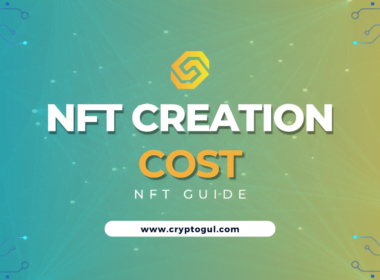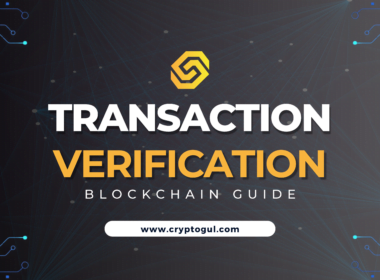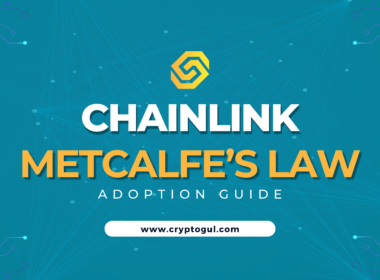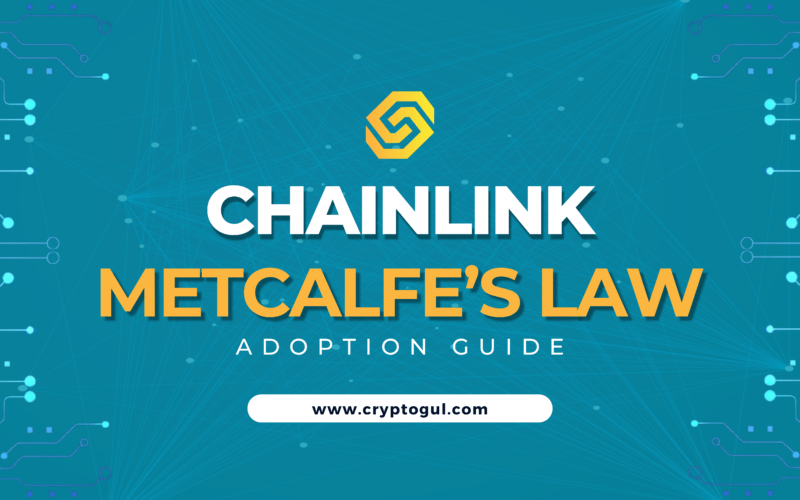The crux of ‘Metcalfe’s law Chainlink’ analysis hinges on a singular, pivotal question: How does the expanding ecosystem of Chainlink impact LINK’s valuation through the lens of Metcalfe’s Law? In this piece, we delve into how the network’s growth trajectory could power an exponential increase in LINK’s value, directly correlating to the surge in network participation. We offer insights into this network value relationship without forecasting precise outcomes.
Key Takeaways
Chainlink’s network value and the future price of its native token, LINK, exemplify the exponential growth outlined by Metcalfe’s Law, fueled by increased adoption and the network’s expanding connectivity through innovative technologies like the Chainlink Cross-Chain Interoperability Protocol (CCIP).
Strategic partnerships with industry giants and ecosystem expansion are key drivers in LINK’s price trajectory, with predictive analyses forecasting substantial growth in token value as Chainlink cements its market position through collaborations and utility in various applications.
Staking mechanisms within Chainlink incentivize participation and can potentially influence the LINK market price by increasing demand, reducing circulating supply, and enhancing the network’s security, which in turn may contribute to a positive price momentum.
Exploring Metcalfe’s Law in the Context of Chainlink

Chainlink’s exponential growth can be understood via Metcalfe’s Law. By facilitating a connection between blockchains and real-world data, Chainlink has grown its network exponentially, epitomizing the network effects described by Metcalfe’s Law.
According to the law, a network’s value expands exponentially with the rise in connected users. The growing adoption of Chainlink’s oracle services, together with this connectivity, can potentially establish a positive feedback loop, thereby boosting the network’s overall value and influencing LINK’s future value.
The Fundamentals of Metcalfe’s Law
Metcalfe’s Law, expressed as n^2, suggests a network’s value is directly proportional to the square of its connected users. This principle can be aptly applied to Chainlink’s price analysis, as the value of its network grows with the number of users. The law indicates a nonlinear value increase, prompting further expansion and heightened network engagement.
Bitcoin’s 2017 bull run exemplifies Metcalfe’s Law in practice, with escalating adoption and demand propelling its price surge. This law can serve as a valuable instrument for predicting the minimum link price for LINK’s future.
Chainlink’s Network Growth Dynamics
Chainlink’s network growth is bolstered by its unique interoperability with other blockchains. The Chainlink Cross-Chain Interoperability Protocol (CCIP) ensures seamless functionality across various blockchain ecosystems, which is a crucial factor in driving developer adoption and fostering network growth.
Moreover, the integration of existing APIs with Chainlink is highly feasible, thus broadening its utility across various applications and influencing Chainlink prices.
Implications for LINK Token Valuation
The growth of Chainlink’s network, in accordance with Metcalfe’s Law, has significant implications for LINK token valuation. Predictive analysis suggests a substantial increase in the value of LINK in the coming years. The projected average trading price of Chainlink in December 2024 is estimated to be $7.83, and by 2040, it is expected to reach an astounding $10,063.12.
These forecasts provide a promising outlook for the future of LINK, making it an attractive asset in the crypto market.
The Synergy of Smart Contracts and Network Effects

The interaction of smart contracts and network effects is key to boosting Chainlink’s capabilities. Smart contract developers within the Chainlink ecosystem facilitate the smooth interaction between on-chain and off-chain resources, significantly broadening the capabilities of blockchain applications through the incorporation of real-world data.
Furthermore, they significantly contribute to magnifying the Chainlink network effects by allowing developers to utilize a secure blockchain infrastructure and a robust ecosystem of smart contracts. This creates a reinforcing cycle, as more users connect and interact with the system, thereby increasing the network’s value exponentially, in line with Metcalfe’s Law.
Enhancing Smart Contract Capabilities
By offering secure and dependable data delivery solutions, Chainlink’s decentralized oracle network considerably enhances smart contract capabilities. Chainlink’s high accessibility for integration and its broad application utility stem from its minimal coding requirement for incorporating existing APIs.
The Chainlink decentralized oracle network is a prime example of decentralized oracle networks, furnishing smart contracts with an array of real-world data from external data sources, augmenting their execution via secure, decentralized, and reliable data feeds that cater to a multitude of use cases.
Developer Network Effect in Action
Innovation and growth in Chainlink are largely driven by the developer network effect. The value of the Chainlink system expands and establishes a positive feedback loop as more developers construct and incorporate applications using Chainlink’s technology. This effect drives network adoption, fortifies the community, and improves the utility and resilience of Chainlink.
Additionally, Chainlink’s technology has been deployed to devise a variety of smart contract applications and explore probable uses for dynamic NFTs, including:
Event-based rewards
Crowd-sourced voting
Certifications
Interoperability as a Value Multiplier
Interoperability, defined as the capability of different systems to collaborate, functions as a value enhancer for Chainlink. Chainlink’s Cross-Chain Interoperability Protocol (CCIP) facilitates the secure transfer of messages, tokens, and data across various blockchains, offering a unified interface for all cross-chain use cases. This expands the capabilities of decentralized applications (dApps) and enables established systems to access the benefits of the smart contract economy, leading to:
the creation of new revenue streams
increased efficiency and scalability
improved security and trust
enhanced user experience
Chainlink’s Ecosystem Expansion and LINK’s Price Trajectory

LINK’s price trajectory, also known as the link price, is influenced by Chainlink’s ecosystem expansion, strategic partnerships, and a strong market position. Chainlink’s market position and credibility have been reinforced by its significant partnerships with industry leaders such as Swift, Amazon Web Services, Associated Press, and Google BigQuery, which exhibit institutional adoption and demand for its services.
Predictive analysis suggests that LINK is poised for substantial growth, potentially reaching new highs in the upcoming years. Time to examine the specifics.
Strengthening the Decentralized Oracle Network
The constant addition of new node operators and data providers strengthens Chainlink’s decentralized oracle network, thereby enhancing its value and utility. The network is pivotal for facilitating the formation of hybrid smart contracts by amalgamating on-chain code and off-chain infrastructure.
The enhancement of Chainlink’s network is aided by new node operators and data providers who augment its decentralization and security, consequently raising the value and practicality of the Chainlink ecosystem.
Strategic Partnerships and Market Position
Chainlink’s market position is cemented and further growth is spurred by strategic partnerships with a range of blockchain projects and decentralized applications. Increased institutional adoption and demand for Chainlink’s services are underscored by its partnerships with:
Swift
Amazon Web Services
Associated Press
Google BigQuery
These collaborations attest to the market’s broad recognition and value of Chainlink’s offerings. Moreover, Chainlink offers comprehensive case studies showcasing how top industry teams have achieved success through their partnerships.
For instance, Swift utilized Chainlink to facilitate the transfer of tokenized assets across multiple blockchains, and Aavegotchi integrated Chainlink VRF into their operations.
Predictive Analysis: Assessing LINK’s Price Fluctuations
As Chainlink’s network keeps expanding and gaining adoption, chainlink price analysis points to potential growth in LINK’s value. Short-term forecasts indicate that LINK could undergo significant growth, with a predicted annual low of $15.36 in 2025 and a potential hike of 350.64% by 2026, indicating a positive trajectory in its price movements. This chainlink price forecast aligns with the overall market sentiment and the increasing adoption of the platform, making chainlink price prediction a topic of interest for investors.
Moreover, projections suggest that by 2031, the chainlink price could possibly hit a peak value of $292.77, with an expected average trading price of $251.55. These predictions convey robust confidence in the sustained growth and adoption of Chainlink’s network.
The Role of Staking in Chainlink’s Metcalfe’s Law Equation

Staking has a meaningful impact on Chainlink’s Metcalfe’s Law equation, motivating participation, affecting node operators and data providers, and shaping LINK’s market price. By offering rewards to users for securing and maintaining the network, staking fosters engagement in the Chainlink network.
Moreover, it plays an important part in compensating node operators for providing real-world data to smart contracts and bolstering the security of the Chainlink network.
Incentivizing Participation with LINK Staking
Through rewards for securing and maintaining the network, LINK staking encourages user engagement in the Chainlink network. The rewards are determined by the Chainlink network, and community stakers can anticipate an effective annualized reward rate of 4.75% in LINK.
Staking LINK can have a significant impact on its liquidity by restricting the availability of tokens, reducing their ease of conversion into cash.
Impact on Node Operators and Data Providers
Staking influences node operators and data providers by offering them financial incentives to supply precise and dependable data to the network. Node operators and data providers play a key role in enhancing the robustness of Chainlink’s decentralized oracle network. Their responsibilities include operating the infrastructure that supports and safeguards the oracle networks, ensuring secure access to real-world data for smart contracts.
Staking’s Influence on LINK’s Market Price
The initiation of staking mechanisms can affect LINK’s market price by:
Boosting token demand
Propelling its value
Enhancing security
Providing rewards to stakers
Decreasing the circulating supply
All of these factors can have a significant impact on the market price of Chainlink’s LINK token.
Navigating the Investment Landscape: Is Chainlink a Good Investment?
Investment in Chainlink necessitates a comprehensive comprehension of its competitive advantage, risk assessment, and investment strategies. Chainlink’s competitive advantage stems from its decentralized oracle network, pivotal for facilitating the development of hybrid smart contracts by merging on-chain code with off-chain infrastructure. Nonetheless, like all investments, it carries its own set of risks and hurdles, which warrant further exploration.
Evaluating Chainlink’s Competitive Edge
Chainlink’s competitive advantage is derived from:
Its decentralized oracle network
Security
Adaptability
Cross-chain compatibility
This positioning it as a formidable player in the blockchain realm.
Chainlink’s competitive advantage is rooted in:
Its decentralized oracle network
Integration of various independent oracle node operators
Dependable data sources
Furnishing real-world data to smart contracts on the blockchain.
Risk Assessment: Challenges and Considerations
Investment risk assessment for Chainlink comprises elements like market volatility, regulatory shifts, and competition from other initiatives. Market volatility can exert a substantial influence on Chainlink’s price. Known for their volatility, cryptocurrency markets include Chainlink among their ranks. Price swings can be substantial, and investors should be prepared for the possible impacts of market volatility on Chainlink’s price.
Investment Strategies for Digital Assets
Investment strategies for digital assets such as Chainlink ought to encompass comprehensive research, risk management, and a long-term outlook. Suggested strategies for managing cryptocurrency investments like Chainlink encompass:
Portfolio diversification
Use of dollar-cost averaging
Adherence to the buy and hold approach
Staking for reward accumulation
Utilization of technical analysis to measure market sentiment.
How to Buy Chainlink and Store Your LINK Tokens

The process of buying Chainlink and storing LINK tokens entails transactions on crypto exchanges, selection of a suitable crypto wallet, and investment management. Chainlink tokens can be obtained via trusted cryptocurrency exchanges such as Binance, Coinbase, and Gemini.
Upon obtaining LINK tokens, investors are recommended to actively monitor market trends, keep up-to-date with Chainlink project updates, and continually assess and adjust their investment strategy as required.
Purchasing LINK on Crypto Exchanges
Reputable crypto exchanges like Binance, Coinbase, and Gemini are platforms where LINK tokens can be purchased. The standard method for purchasing Chainlink on cryptocurrency exchanges entails:
Account creation
Payment method addition
Trade initiation
Chainlink selection from the asset list
Specification of the purchase amount.
Choosing the Right Crypto Wallet
Selecting an appropriate crypto wallet to store LINK tokens is vital for ensuring investment security and control. Software wallets like MetaMask or Trust Wallet, and hardware wallets such as Ledger or Trezor, are secure options for storing LINK tokens. Compared to keeping tokens on exchanges, these options provide full control over your investment and enhanced security.
Managing Your Investment
Investment management in Chainlink encompasses tracking market trends, staying updated on project developments, and modifying your strategy when necessary.
After obtaining LINK tokens, it is recommended that investors actively follow market trends, keep updated with Chainlink project developments, and regularly assess and adjust their investment strategy as required.
Summary
In conclusion, Chainlink’s potential and value, underpinned by Metcalfe’s Law, is tremendous. The growth of Chainlink’s network, the synergy between smart contracts and network effects, the ecosystem expansion and LINK’s price trajectory, the role of staking, and the investment landscape all contribute to the compelling case for Chainlink as a promising digital asset. The future of Chainlink, bolstered by the principles of Metcalfe’s Law, holds immense potential, making it a fascinating area for investors and enthusiasts alike.
Frequently Asked Questions
What is Metcalfe’s law in blockchain?
Metcalfe’s law in blockchain states that the value of a network is directly proportional to half the square of the number of its users or nodes, highlighting the importance of network size in security and resistance to attacks. In the context of cryptocurrencies like Bitcoin, a larger and more decentralized network decreases the risk of single points of failure or control.
What is an example of Metcalfe’s law?
Metcalfe’s Law states that the value of a network is proportional to the square of the number of connected users. For example, social media platforms like Facebook and Twitter demonstrate this law as their value increases with the number of active users.
Is Chainlink dependent on Ethereum?
No, Chainlink is not dependent on Ethereum. While it originated on Ethereum, it can work across any blockchain with smart contract functionality. This allows for versatility and compatibility beyond Ethereum.
What is Chainlink backed by?
Chainlink is backed by decentralized and Sybil-resistant networks, making it the most decentralized oracle network with security-reviewed nodes and professional teams. This ensures the creation of tamper-proof oracle networks that can scale up as the value being secured rises.
Does Chainlink have a future?
Chainlink shows promising potential with price forecasts suggesting substantial growth, with predictions ranging from $15.50 by 2024 to $213.1 by 2030. The market sentiment appears bullish, indicating a positive trajectory for Chainlink.








